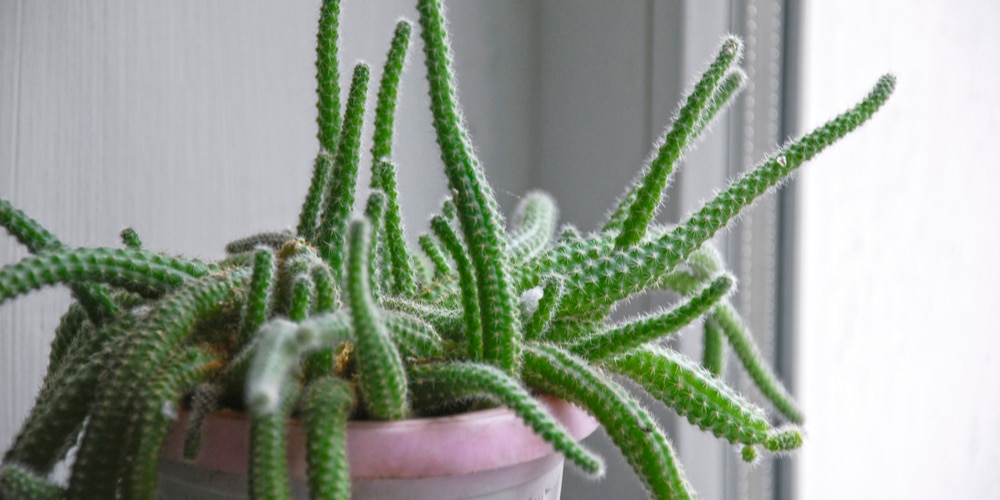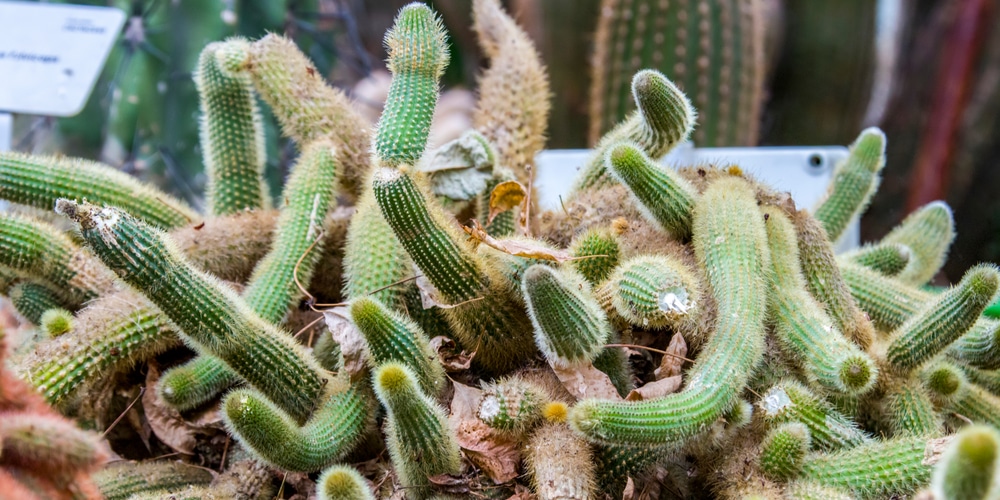The dog tail cactus, an epiphytic cactus, is a native of the tropical rainforests of Southern America. This means they are air plants and can grow on top of other plants or trees, in the nooks and crannies of branches, or even on rocks. In their native habitat, they can grow fairly large, winding their way up trees.
If you’re interested in learning how to care for a dog tail cactus, keep reading. This guide will teach you everything you need to know, from watering to fertilizing to propagation.

| Botanical Name | Strophocactus Testudo |
| Common Name | Dog Tail Cactus |
| Plant Type | Perennial |
| Flower Color | White buds that open to reveal small, yellow flowers |
| Size When Mature | 130 inches |
| Bloom Time | Late fall to early spring |
| Sun Requirements | Full to Partial Sun |
| USDA Hardiness Zones | 7 – 11 |
| Soil PH Range | 3.5 – 7.3 |
| Soil Type | Acidic to neutral, fast-draining potting mix soil |
| Water Needs | Medium |
| Native Area | South America |
What You Need to Know About Dog Tail Cactus
Dog tail cacti are easily recognizable by their long, pendulous stems covered in rows of small, sharp spines that give the plant its name. Their trailing stems make them popular plants for hanging baskets. They can also be trained to grow up a support or left to hang freely.
When taken care of as a house plant, they will only grow about a foot tall. The dog tail cactus has long, flat leaves that are sharply pointed at the tips and have small spines along their edges. The leaves are arranged in a spiral pattern around the main stem of the plant. As the plant grows, new stems will branch off from the main stem, giving the plant a fuller appearance.
The flowers of the dog tail cactus are small and white, growing in clusters at the tips of the stems. They bloom in the late spring and early summer.
Dog tail cacti are not difficult to care for, but there are a few things to keep in mind. Here are some tips on how to care for your dog tail cactus.
How to Care for Dog Tail Cactus
Here’s everything you need to know about growing and caring for a thriving dog tail cactus:
Light
Typically found in shaded areas in their natural habitat, dog tail cacti prefer bright, indirect light. They can be both grown indoors and outdoors. When indoors, placing them near a bright window is ideal. If grown outdoors, ensure they receive dappled sunlight throughout the day.
Unlike other cacti, dog tail cacti do not tolerate direct sunlight well and will scorch easily. They live in tropical rainforests and are used to tree canopies providing filtered sunlight.
When grown in low light conditions, dog tail cacti will grow slower and produce fewer flowers. If you notice your plant isn’t growing as it should be, or if the stems are starting to stretch, it’s likely not getting enough light.
Water and Soil Needs
Dog tail cacti are succulents and, like other succulents, they store water in their leaves. This means they don’t need to be watered as often as other plants. Once a week is enough and would be sufficient unless the plant is placed in an extremely dry environment. In this case, water every 5 days.
Plant in a fast, well-draining soil, allowing the water to flow freely. A cactus mix or succulent mix will work well.
Soak the soil until it’s saturated, then allow it to dry out completely before watering again.
Although they’re particular about the amount of water and sunlight it receives, this plant can thrive in a wide range of soil conditions. It does fairly well in soil pH ranging from 3.5 to 7.3.
Temperature Requirements
Dog tail cacti are tropical plants but can tolerate a wide range of temperatures. They prefer warm conditions and will do best in temperatures between 40 and 90 degrees Fahrenheit. However, they can’t tolerate frost and thrive well in USDA zones 7 – 11.
Fertilizer
The best fertilizer to use on a dog tail cactus is a diluted fertilizer. During its early and growing years, it might not need as much. However, once the plant has become root-bound (and this happens often), it might need a little more help. Using a fertilizer specifically for cacti plants is preferred. Feed them during the growing months to help maintain their color and size.
Cactus fertilizer is typically high in potassium and low in phosphorus.
Common Diseases
One of the best things about cacti plants is that they don’t often succumb to diseases. However, some diseases may be a result of overwatering or planting in poorly drained soil. Root rot is the number one killer of cacti plants and is caused by too much water.
Additionally, when you overwater, the soil is often left moist, which makes a perfect environment for fungi and bacteria to grow. Diseases like powdery mildew, fungal leaf spots, and bacterial blights can develop.
Luckily, these diseases can be controlled by making sure the plant is receiving the correct amount of water and sunlight.
Dog Tail Cactus Propagation
You can grow dog tail cactus from seeds. However, this can be quite challenging. During their growing years, these plants are fragile and may require more care than usual. However, if you want to grow new specimens, you can do so by propagating through stem cuttings.
Considering you have followed the above instructions on proper care, you’ll have a healthy plant with stems viable for propagation.
To propagate, use a sharp knife or garden shears to cut the stems from the joint. Don’t plant it yet – wait for the stem to callous over. You may have to wait for a few days or more. Once your stem has calloused over, you can plant it in a well-draining cactus mix. Bury the stem approximately 1-2 inches in your potting mix, and water lightly. A dog tail cactus is very similar to a rat tail cactus.

